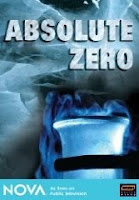What used to be humanity's most fearsome and dangerous enemy has become a friend. Without it, we would have no freezers or quantum computers. What is it? Cold. Absolute Zero is a documentary about the science and history of cold. This Nova program unveils the truth about the incredible potential of a few frigid degrees.
The documentary begins by showing reenactments and interviews to tell about the history of cold. For some time, cold had been thought to be simply the absence of heat. Many theories, such as the caloric theory that heat is a liquid matter that acts upon atoms, were formulated and modified throughout the years until our modern understanding of cold was formed. Once the knowledge of how to create cold was gained, inventions like refrigerators, air conditioners, and ice machines took off. The inventions had a profound effect on modern society.
The term “absolute zero” refers to the temperature at which a given substance is under no pressure. This originates from the idea that pressure and temperature are directly related. The higher the pressure, the higher the temperature, and so the lower the pressure (0), the lower the temperature (calculated to be around -273°C, or absolute zero). The idea behind absolute zero is that this is the coldest temperature possible in the universe, because there is nothing less than zero pressure. This idea was first suggested in the early eighteenth century by French physicist Guillaume Amontons, who made a major contribution to the science of his day.
The Race for Absolute Zero, the second part of the program, tells of the quest to achieve absolute zero. Heike Kamerlingh Onnes and James Dewar were two scientists who raced to liquify gasses such as hydrogen and eventually helium in order to maintain extremely low temperatures. Onnes finally succeeded in liquifying helium at 5° above absolute zero. These were major milestones along the temperature scale. A group of researchers won the Nobel prize in 2001 when they at last produced Bose-Einstein condensates, particles extraordinarily close to absolute zero.
What is interesting about absolute zero is that at such low temperatures, quantum mechanics comes into play. Atoms begin to form into wavelike structures and lose their individual identities. Atomic particles are at different locations at once, and there is no clear separation between them. Quantum principles rule in this world of confusion, probability, darkness, and cold.
Since then, scientists all over the world are using condensates to achieve such feats as slowing down light waves and storing information. The potential of these new innovations is obvious. Not only are we able to harness everyday chill for use in our refrigerators and air conditioners, but now we can use ultimate cold to do even more fantastic things. An entirely new realm of science, technology, and engineering has opened up, and we owe it all to the cold.
